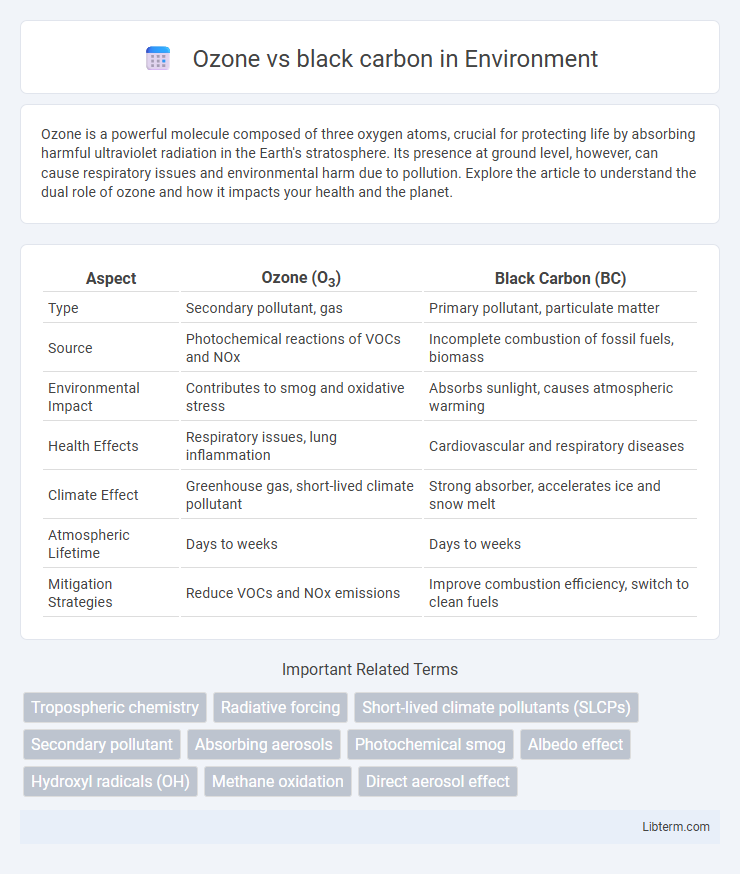Ozone is a powerful molecule composed of three oxygen atoms, crucial for protecting life by absorbing harmful ultraviolet radiation in the Earth's stratosphere. Its presence at ground level, however, can cause respiratory issues and environmental harm due to pollution. Explore the article to understand the dual role of ozone and how it impacts your health and the planet.
Table of Comparison
| Aspect | Ozone (O3) | Black Carbon (BC) |
|---|---|---|
| Type | Secondary pollutant, gas | Primary pollutant, particulate matter |
| Source | Photochemical reactions of VOCs and NOx | Incomplete combustion of fossil fuels, biomass |
| Environmental Impact | Contributes to smog and oxidative stress | Absorbs sunlight, causes atmospheric warming |
| Health Effects | Respiratory issues, lung inflammation | Cardiovascular and respiratory diseases |
| Climate Effect | Greenhouse gas, short-lived climate pollutant | Strong absorber, accelerates ice and snow melt |
| Atmospheric Lifetime | Days to weeks | Days to weeks |
| Mitigation Strategies | Reduce VOCs and NOx emissions | Improve combustion efficiency, switch to clean fuels |
Introduction: Ozone vs Black Carbon
Ozone and black carbon are two significant atmospheric pollutants with distinct sources and impacts on climate and human health. Ozone, a reactive gas found in the troposphere, contributes to smog formation and respiratory issues, while black carbon consists of fine particulate matter from incomplete combustion, influencing both air quality and global warming. Understanding their chemical properties and environmental roles is critical for developing targeted pollution control strategies.
Chemical Properties and Formation
Ozone (O3) is a triatomic molecule formed in the stratosphere through the photodissociation of molecular oxygen (O2) by ultraviolet (UV) light, exhibiting strong oxidative properties and high reactivity due to its unstable triatomic structure. Black carbon consists primarily of pure carbon in several linked forms, generated from incomplete combustion of fossil fuels, biofuels, and biomass, characterized by its amorphous structure and significant light-absorbing capacity. While ozone is a reactive oxidant influencing atmospheric chemistry, black carbon acts mainly as a particulate pollutant affecting radiative forcing and climate through its chemical stability and aggregation.
Major Sources of Ozone and Black Carbon
Major sources of ozone include nitrogen oxides (NOx) and volatile organic compounds (VOCs) emitted from vehicles, industrial facilities, and power plants. Black carbon primarily originates from incomplete combustion of fossil fuels, biofuels, and biomass, with significant contributions from diesel engines, residential wood burning, and open biomass burning. Both pollutants contribute to air quality degradation but stem from distinct combustion-related and photochemical processes.
Impact on Air Quality
Ozone is a secondary pollutant formed by photochemical reactions involving nitrogen oxides and volatile organic compounds, significantly contributing to smog and respiratory problems. Black carbon consists of fine particulate matter produced by incomplete combustion of fossil fuels and biomass, impairing lung function and exacerbating cardiovascular diseases. Both pollutants degrade air quality, but ozone primarily affects upper respiratory systems through oxidative stress, while black carbon poses direct inhalation hazards as particulate matter PM2.5.
Effects on Human Health
Ozone exposure primarily affects respiratory health by causing airway inflammation, reduced lung function, and exacerbating asthma and chronic respiratory diseases. Black carbon particles penetrate deep into the lungs and bloodstream, increasing risks of cardiovascular diseases, respiratory infections, and lung cancer. Both pollutants contribute significantly to premature mortality and morbidity worldwide, particularly in urban and industrial areas with poor air quality.
Influence on Climate Change
Ozone and black carbon both significantly influence climate change, but through different mechanisms. Tropospheric ozone acts as a potent greenhouse gas, trapping heat and contributing to global warming, while black carbon absorbs sunlight, directly heating the atmosphere and darkening snow and ice surfaces, accelerating melt. Their combined effects amplify atmospheric warming, with black carbon also affecting cloud formation and regional climate patterns.
Regional Distribution Patterns
Ozone concentrations primarily peak in urban and industrial regions of the Northern Hemisphere, particularly in North America, Europe, and Asia due to photochemical reactions driven by sunlight and precursor emissions. Black carbon shows distinct regional distribution, with highest levels found near fossil fuel combustion sites, biomass burning areas, and developing regions in South Asia and Africa, where incomplete combustion is prevalent. Both pollutants exhibit seasonal variability, with ozone maximized during warmer months and black carbon linked to specific fire seasons and heating periods.
Mitigation and Control Strategies
Mitigation strategies for ozone primarily involve reducing precursor emissions such as nitrogen oxides (NOx) and volatile organic compounds (VOCs) through stricter vehicle emission standards and industrial regulations. Black carbon control focuses on limiting emissions from incomplete combustion sources, including diesel engines, biomass burning, and residential heating, by promoting cleaner technologies and fuel switching. Both pollutants benefit from integrated policies emphasizing air quality monitoring, adoption of renewable energy, and public awareness to achieve significant health and climate co-benefits.
Regulatory Frameworks and Policies
Regulatory frameworks for ozone primarily focus on the National Ambient Air Quality Standards (NAAQS) under the Clean Air Act, which set stringent limits to reduce ground-level ozone due to its harmful health effects. Black carbon regulations often fall under particulate matter (PM2.5) standards, targeting emissions from diesel engines, biomass burning, and industrial activities through policies like the EPA's Diesel Emission Reduction Program (DERA). International agreements, such as the Climate and Clean Air Coalition (CCAC), emphasize joint strategies to mitigate both ozone precursors and black carbon to improve air quality and combat climate change.
Future Outlook and Research Directions
Future research on ozone and black carbon emphasizes advanced atmospheric modeling to accurately predict their climate impacts and interactions. Innovative mitigation strategies aim to reduce emissions through clean energy technologies and enhanced air quality regulations. Emerging studies explore the synergistic effects on human health and ecosystems, driving integrated policies for sustainable environmental management.
Ozone Infographic

 libterm.com
libterm.com